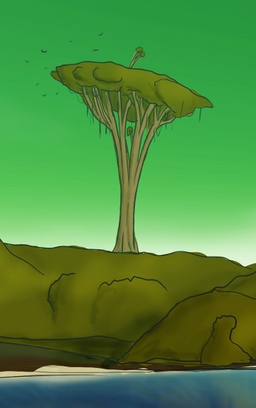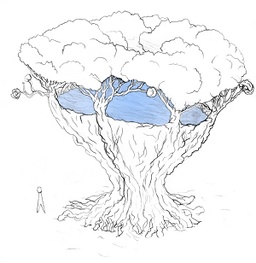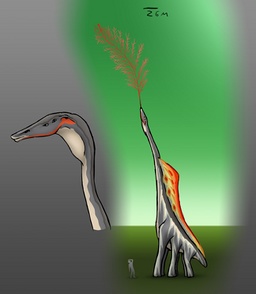Raharrs:Ecosystem
Harr is a tropical world rich in flora and fauna. Textbooks and classification of species have to be constantly updated, since the ecosystems and biomes constantly changes. Life on the planet is divided into categories more or less identical to terrestrial: protozoa, plants, fungi, arthropods and animals.
The animal life of Harr is considered of phylum hexapoda, divided into two large groups of animals that have different anatomy structures. Researchers do not fully agree on how that came to be. The leading theory is that somewhere in the early history of the planet, shortly after emergence of first multi-cellular organisms, a continental drift caused part of the ocean to become completely isolated from the rest of the planet for a long time. That part was large enough to host its own diverse ecosystem, and the isolation lasted long enough so that animals evolved differently from the others. The easiest way to distinct these two clades is the skull structure. The ones that convergently resemble Earth animals in structure are called Unimandibulae, featuring a skull and one jaw that moves vertically. They share the planet with the Bimandibulae clade, with them having a skull with two sets of jaws that are articulated horizontally, like those of insects. They have further anatomical differences from the Unimandibulae, but they are not so obvious without a dissection.
Typical examples of Unimandibulae are the raharrs themselves and their companions, flydogs.
Bimandibulaes, despite having nearly one third of total population of vertebrate animals of the planet, are quite less "complicated" than their Unimandibulae peers, lacking many inventions that their neighbors had evolved. This prevents them from dominating the biosphere, but at the same time it gives them some resilience that provides some edge in the competition.
Distinctive Species
Arknehashe Zannul (Slow Death)
This plant is called Arknehashe Zannul, which can be translated as "slow death". It is a distinct class of parasitic plants and resembles a wide bush. They use animals to not just spread seeds around, but eventually use them as fertilizer. After the pollination, these plants develop pear-shaped (and pear-sized) seed cases on it's branches. Each seed case contains one small needle-shaped seed, with a chamber behind it, that contains gas under a pressure. Seed cases are sensitive to the touch and, upon irritation, they rapidly contract, increasing the pressure in the chambers. This forces the seed to propel forward like a projectile and, with luck, it penetrates the skin of its unfortunate victim. Once inside of the body, under the influence of the warmth and wetness, the seed starts the parasitic part of its life cycle. It sprouts and start to grow roots, which anchors it in the flesh and suck nutrients out. The process is slow and can take months in some cases, hence the name. This becomes incredibly painful for the victim in the late stages. The result depends on where the seed hit the victim. With limbs, the outcome often is "just" necrosis of the tissues and eventual loss of the limb. If the seed is in the torso, the root growth eventually reaches the vital organs of the victim, or clogs the arteries, causing death. After that, the plants continue to use the nutrients available from the rotting corpse, and the roots eventually spread into the ground below. At this point, the plant continues to grow normally. Before the invention of medical surgery, the sting of the plant was often fatal (since the seed is so small, the penetration can easily go unnoticed, and the effects of infestation becomes noticeable only well after the roots are already anchored in the flesh and start to become thick enough to feel like foreign objects) and even if the seed is removed, the remaining roots can still grow for some time and then cause necrosis as they begin to decompose. To clean the affected body part from the roots without just cutting out the affected region is a challenge, even with modern medicine. Still, the plant's seed pods are quite durable and elastic, and were widely used by the raharrs.
Hephrushokh (World Tree)
Gargantuan floral species, holds the galactic record for the tallest floral species discovered. Hephrushokh can easily extend up to half a kilometer in height and its trunk can be more than fifty meters in diameter. Its tree-top is so distant from the surface, that it hosts a whole unique and self-contained ecosystem. It is unclear what caused the tree to favor such immense gigantism, nor how the species survived to this day. These trees are able to reach such awe-inspiring heights via evolving a unique way to transport water and nutrients inside it's trunk. Hephrushokh features outgrowths that come at regular intervals of about 50 meters. These outgrowths are bowl-shaped, and form relatively small ponds of water along the trunk. The tree doesn't have one single water transportation system, instead, it lifts water to the nearest pond outgrowth and deposits it there, and a different capillary system takes over the task of transporting the water to the top from there. Naturally, the trees appear to grow quite slowly, and their lifespan measures in tens of thousands of years. Extremely endangered, less than a hundred Hephrushokhs had left on the entire planet. Eventual extinction without intervention is most likely inevitable, as so far no young tree specimens were found. The current hypothesis is that the tree relied on some symbiotic flying species to carry the pollen across trees, that went extinct a couple of thousand years ago. World Trees hold one of the most important and prominent places across almost all raharrian cultures. In the old times, it was a common belief that the trees held the sky itself above the ground, acting as pillars, and almost uniformly they were regarded with religious awe. Both the tree and the area around it was considered a sacred place. Even today that attitude hasn't completely been replaced by the more secular scientific awe of nature.
Hesha Rushokh (House Tree)
A close relative and possibly an evolutionary descendant of a World Tree. Contrary to their relative, these plants generally don't grow taller than 20 meters. These plants grow mainly in arid areas where rains are uncommon and unpredictable. The tre has only one bowl outgrowth, located at the center of the trunk, that's used to store rainwater that falls into it to nourish the tree during droughts. The bowl is capped and protected from the sun with bushes growing in specific shapes to let trees collect the largest possible amount of water during the infrequent but intense waterfalls. At one point in history House Trees almost went extinct, since many raharrs living in the area kept using the bowl-shaped trunks of the trees as a very convenient frame for housing (hence the name) which severely undercut the tree population.
Hilrrack (Night devil)
Hilrrack is a Bimandibulae species and is one of the most dangerous animals on the planet, remaining the top predator of the food chain even with raharrs in the vicinity, with this situation being preserved through much of their history until the invention of firearms. It is a large animal with a massive set of jaws and tough armor-like skin. They are slow to grow and reproduce and were relatively few and between even in early history, being solitary predators that claimed truly vast hunting grounds to soothe their appetite. That nearly caused them to go extinct when raharrs invented gunpowder and became able to safely hurt the beasts from afar. Hilrracks have a property that they share with many other Bimandibulaes - they do not get old. Hilrracks grow slow and steady, but can last seemingly indefinitely as long as their hunting grounds are able to support their appetite. So far, It looks like all Hilrrack die either from injures or starvation, growing too big to find and catch enough food to supply themselves. The largest skeletons found by the researchers imply specimens that were up to twenty meters in length at the time of their death, with an estimated age of three to four centuries. Hilrrack carved themself a quite sizeable place in raharrs mythology, symbolizing invulnerability, deadly power, and greed.
Tashnusarr (Flydog)
A small canine-size flying animal that played a similar role in Raharrian evolutionary history, becoming one of the first domesticated species.
Rrenkhnusarr (air feeder)
Harr's atmosphere is a home for vast amounts of floating photosynthesizing microorganisms, which are part of the reason that the skies of the planet are green. Some creatures evolved to live off these clouds of aeroplankton.
This species, called Rrenkhnusarr, catch aeroplankton by spewing out a long tongue that then unwraps into a web of sticky hair-like structures that catch the food. And it's not always only the plankton, Rrenkhnusarr can and will swallow essentially anything that will stick to its tongue, including flying creatures. On the back of the torso and lower part of the neck is a foldable fin, which doubles as an organ for heat management and its bright coloration is very important during mating rituals.
Its long neck allows it to reach up to 16 meters in height, making it one of the biggest, and by far the tallest animal to ever exist on the whole planet. However, the first vertebrae fused together to support the neck, resulting in a very limited flexibility at the base. Essentially, the creature is unable to bend its head down to the ground. Its main defense against predators that dare to attack such a massive target is neurotoxin-producing glands in the legs and the legs themselves - for animals of that size and lifestyle, Rrenkhnusarr are surprisingly nimble and fast to react to threats. One of its most notable adaptations, besides the tongue, is the second "heart". Even with a powerful heart, it is not easy to pump liquid that high up in the air, so these species developed sort of secondary heart at the top of their necks. It consists out of a long tube of muscular tissue around the main artery, starting at the base of the skull, that contracts rhythmically and thus acts like a valveless pump, helping the blood flow upwards to reduce the blood pressure.
| Leaving the Cradle | The Cliff World | ||||||
|---|---|---|---|---|---|---|
| Species |
|  | ||||
| Organizations | Alliance | Independent Worlds | Science Corporation | Politics | |||||
| Technologies | Hephrene | Interstellar Travel | Spaceships | |||||
| Places | Planet Harr (Nelnusarr star) | "Shining" Space station | "Dawn" class spaceships | Artifact X | |||||
| Characters | Gharr | Zane | Hekaht | Ahshu | Quantum | Nea | Dan | Mark | Val | ! Virus | |||||
| Events | ! Overall chronology | |||||
| Further reading: | Civilization development stages | Instruments | Ideas | | ||||||




